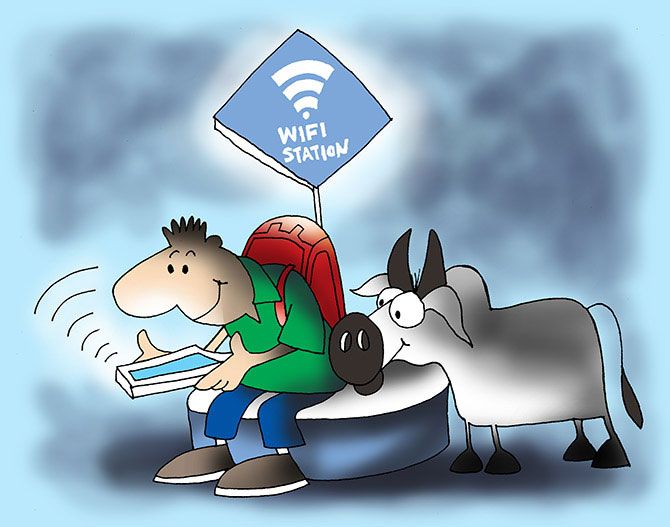 | « Back to article | Print this article |
'The Make in India target of getting manufacturing to account for 25% of GDP by 2022 is quite impossible to achieve.'
'As for the role of technology in the average Indian's life, it is still quite basic -- mobile phones and Mars successes notwithstanding,' says T N Ninan.
Illustration: Uttam Ghosh/Rediff.com

Can India become a developed country by 2022? That is the prospect the prime minister held out at Kedarnath on October 20.
The question begs a definition of what we might mean by 'developed'.
One way to answer that is to look at the structure of the economy, its financial development, and its manufacturing prowess.
For instance, the developed economies usually have a high component of gross domestic product comprising the industrial and service sectors. India does have a predominant service sector, but much of it is not in what might be termed the 'modern' segment of the economy.
And the manufacturing sector is smaller in relation to the whole economy than for virtually all of East Asia, let alone the more advanced economies.
Moreover, about half the population is still engaged in agriculture -- and farmers are by and large a distressed lot. Most of this will change only slowly, despite ambitious targets.
For instance, the Make in India target of getting manufacturing to account for 25 per cent of GDP by 2022 is quite impossible to achieve.
As for the role of technology in the average Indian's life, it is still quite basic -- mobile phones and Mars successes notwithstanding.
On the other hand, India does have sophisticated companies in the manufacturing and services sectors, and a well-developed financial system, even if its penetration into the total economy is still work in progress.
The stock market size in relation to GDP is substantial as is the level of financial savings in the system.
Even on the troubled question of infrastructure, the country does not do as badly as one might have feared.
In a ranking of countries on logistics (which covers trade infrastructure, international shipments, timeliness, customs, etc), the country does not do at all badly; the World Bank places it 35th in a listing of 160 countries on a logistics index, in the company of Turkey and Portugal, and well ahead of such countries as Thailand and Brazil.
Moving away from economic structures and systems, there is the question of income levels and social indicators.
The annual UN Human Development Reports show that India moved from a 'low' human development country to the 'medium' category about a decade ago.
At the present rate of progress, it might take the country another decade before it moves into the 'high' development category (where China is). There is also a 'very high' development category.
The human development index is a composite of three indicators: Per capita income, levels of schooling and life expectancy.
On the first of these, the country's per capita income of about $1,850 puts it in the 'lower-middle income' category. To cross into the 'higher-middle income' category (using the World Bank's definition of these terms) would mean more than doubling per capita income -- which is the work of at least the next decade, probably more.
Reaching the global average for per capita income would mean a further doubling and more, and is a very distant prospect.
When it comes to literacy, India is ranked 124th in a listing of 160 countries, behind such countries as Cambodia, Cameroon and Eritrea.
The country's literacy rate is still short of 75 per cent, whereas as many as 90 countries (including Vietnam and even Myanmar) report more than 90 per cent literacy.
In other words, there is a long way to go.
As for health indicators, India's rank on life expectancy is not very different from the one on literacy: 125th in a listing by the World Health Organisation of 183 countries.
India's figure of 68.3 years compares with the fact that 67 countries score 75 years and more. It is next to impossible for India to improve its life expectancy to that level by 2022.
If these are reasonable indicators with which to assess whether a country is 'developed' or not, then the reality is that India in its entirety has no hope of qualifying in the next five years. To be taken seriously, targets must be attainable.